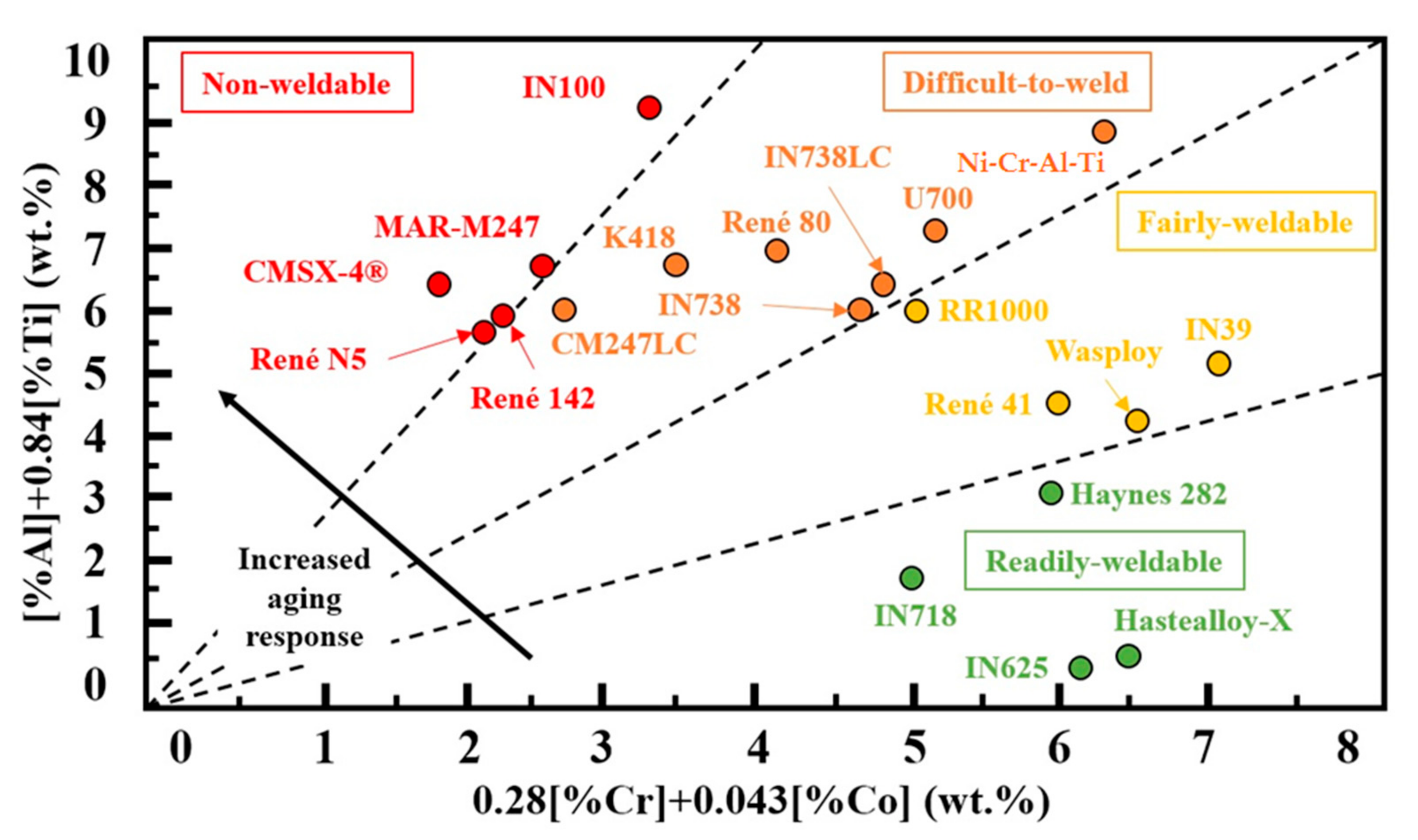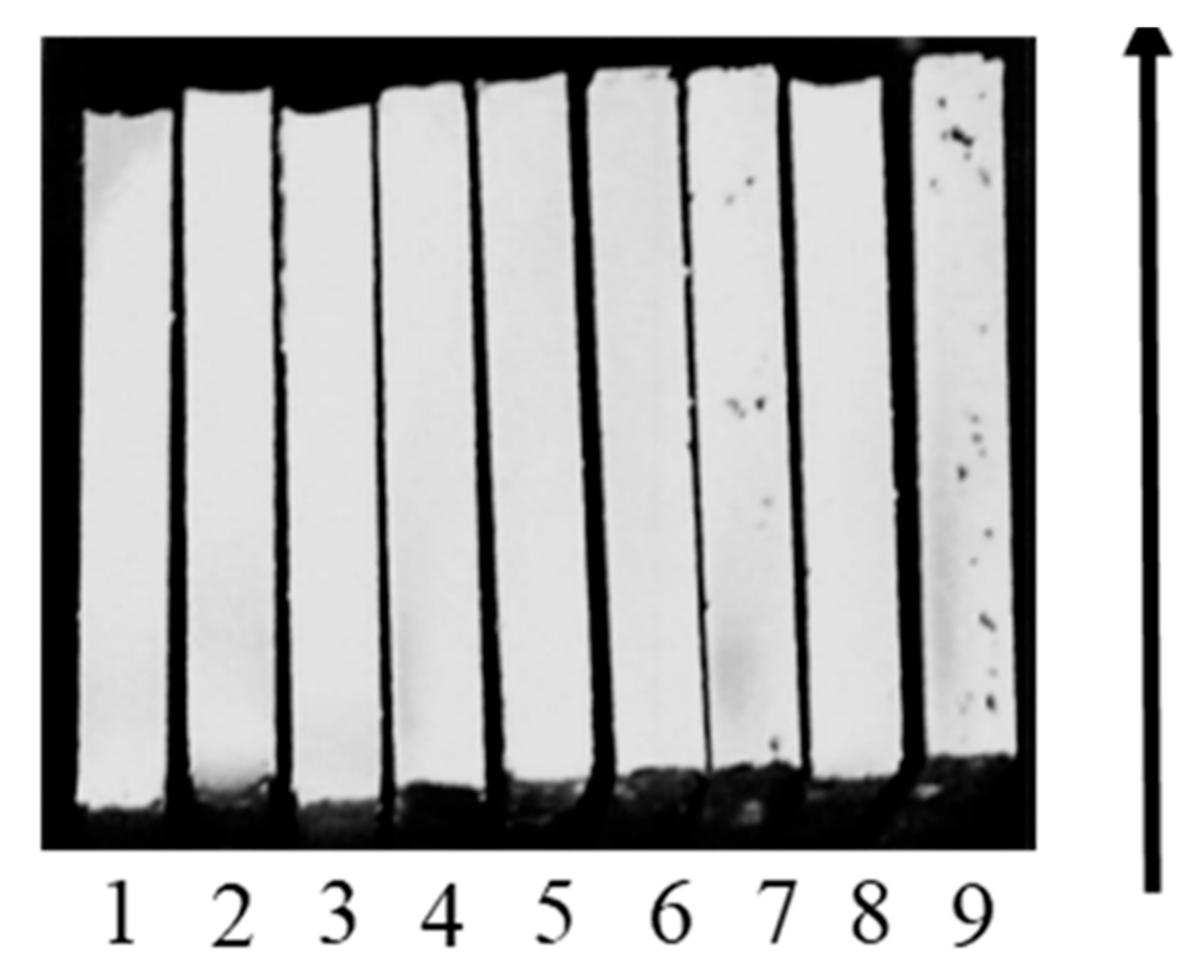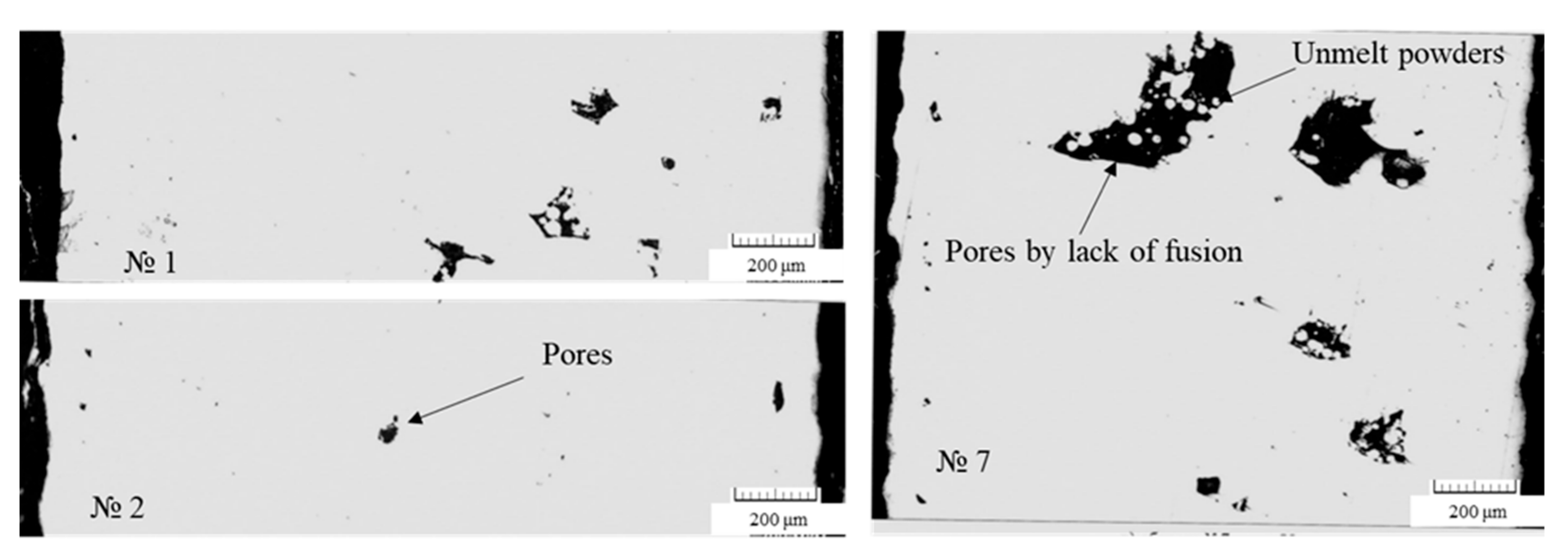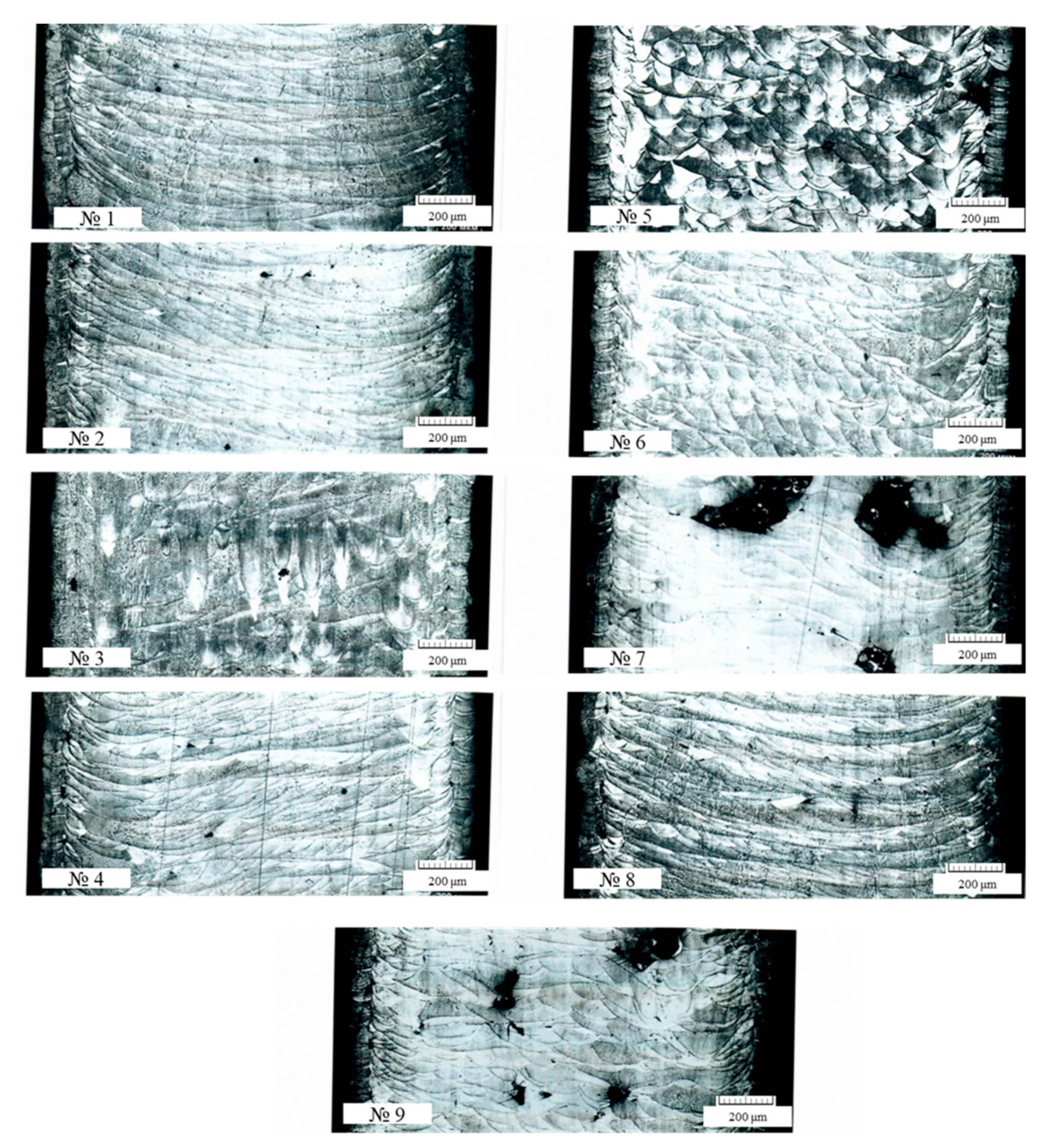Multiresponse Optimization of Selective Laser Melting Parameters for the Ni-Cr-Al-Ti-Based Superalloy Using Gray Relational Analysis
Abstract
1. Introduction
2. Materials and Methods
3. Results and Discussion
3.1. Powder Distribution
3.2. Microstructural Characterization and Mechanical Property Tests
3.3. Gray Relational Analysis
4. Conclusions
- -
- The level of tensile strength on the test samples varied from 774.7 to 949.0 MPa, with a relative elongation from 5.2% to 10.2%;
- -
- The highest tensile strength (949 MPa), with an average level of plasticity (8.4%), was obtained on the samples manufactured using technological modes corresponding to a VED of 66.7 J/mm3 at a laser power of 300 W, a scanning speed of 600 mm/s, and a hatch distance of 0.15 mm;
- -
- The highest ductility (10.2%), with a high level of tensile strength (908.4 MPa), was observed on the samples manufactured using technological modes corresponding to a VED of 34.7 J/mm3 at a laser power of 250 W, a scanning speed of 120 mm/s, and a hatch distance of 0.12 mm.
Author Contributions
Funding
Institutional Review Board Statement
Informed Consent Statement
Data Availability Statement
Conflicts of Interest
References
- Popovich, A.A.; Sufiiarov VSh Borisov, E.V.; Polozov, I.A.; Masaylo, D.V. Design and manufacturing of tailored microstructure with selective laser melting. Mater. Phys. Mech. 2018, 38, 1–10. [Google Scholar]
- Verma, S.; Kumar, A.; Lin, S.-C.; Jeng, J.-Y. A bio-inspired design strategy for easy powder removal in powder-bed based additive manufactured lattice structure. Virtual Phys. Prototyp. 2022, 17, 468–488. [Google Scholar] [CrossRef]
- Gogolewski, D.; Kozior, T.; Zmarzły, P.; Mathia, T.G. Morphology of Models Manufactured by SLM Technology and the Ti6Al4V Titanium Alloy Designed for Medical Applications. Materials 2021, 14, 6249. [Google Scholar] [CrossRef]
- Verma, S.; Yang, C.-K.; Lin, C.-H.; Jeng, J.Y. Additive manufacturing of lattice structures for high strength mechanical interlocking of metal and resin during injection molding. Addit. Manuf. 2022, 49, 102463. [Google Scholar] [CrossRef]
- Sufiiarov VSh Popovich, A.A.; Borisov, E.V.; Polozov, I.A. Layer thickness influence on the inconel 718 alloy microstructure and properties under selective laser melting. Tsvetnye Met. 2017, 1, 77–82. [Google Scholar]
- Sotov, A.V.; Agapovichev, A.V.; Smelov, V.G.; Kokareva, V.V.; Dmitrieva, M.O.; Melnikov, A.A.; Golanov, S.P.; Anurov, Y.M. Investigation of the IN-738 superalloy microstructure and mechanical properties for the manufacturing of gas turbine engine nozzle guide vane by selective laser melting. Int. J. Adv. Manuf. Technol. 2020, 107, 2525–2535. [Google Scholar] [CrossRef]
- Sanchez, S.; Smith, P.; Xu, Z.; Gaspard, G.; Hyde, C.J.; Wits, W.W.; Ashcroft, I.A.; Chen, H.; Clare, A.T. Powder Bed Fusion of nickel-based superalloys: A review. Int. J. Mach. Tools Manuf. 2021, 165, 103729. [Google Scholar] [CrossRef]
- Zhang, H.; Li, C.; Guo, Q.; Ma, Z.; Huang, Y.; Li, H.; Liu, Y. Hot tensile behavior of cold-rolled Inconel 718 alloy at 650 °C: The role of δ phase. Mater. Sci. Eng. A 2018, 722, 136–146. [Google Scholar] [CrossRef]
- Tomus, D.; Rometsch, P.A.; Heilmaier, M.; Wu, X. Effect of minor alloying elements on crack-formation characteristics of Hastelloy-X manufactured by selective laser melting. Addit. Manuf. 2017, 16, 65–72. [Google Scholar] [CrossRef]
- Haafkens, M.H.; Matthey, G.H. A New Approach to Weldability of Nickel-Base As-Cast and Powder Metallurgy Superalloys. Weld J. 1982, 61, 25. [Google Scholar]
- Marchese, G.; Parizia, S.; Saboori, A.; Manfredi, D.; Lombardi, M.; Fino, P.; Ugues, D.; Biamino, S. The Influence of the Process Parameters on the Densification and Microstructure Development of Laser Powder Bed Fused Inconel 939. Metals 2020, 10, 882. [Google Scholar] [CrossRef]
- Sufiyarov, V.S.; Borisov, E.V.; Polozov, I.A.; Masailo, D.V. Control of structure formation in selective laser melting process. Tsvetnye Met. 2018, 7, 68–74. [Google Scholar] [CrossRef]
- Hu, Y.; Kang, W.; Zhang, H.; Chu, C.; Wang, L.; Hu, Y.; Ding, Y.; Zhang, D. Hot corrosion behavior of IN738LC alloy formed by selective laser melting. Corros. Sci. 2022, 198, 110154. [Google Scholar] [CrossRef]
- Li, J.; Hu, J.; Cao, L.; Wang, S.; Liu, H.; Zhou, Q. Multi-objective process parameters optimization of SLM using the ensemble of metamodels. J. Manuf. Process. 2021, 68A, 198–209. [Google Scholar]
- Ahmed, I.; Barsoum, G.; Haidemenopoulos, R.K. Abu Al-Rub, Process parameter selection and optimization of laser powder bed fusion for 316L stainless steel: A review. J. Manuf. Process. 2022, 75, 415–434. [Google Scholar] [CrossRef]
- Kamath, C.; El-Dasher, B.; Gallegos, G.F.; King, W.E.; Sisto, A. Density of additively-manufactured, 316L SS parts using laser powder-bed fusion at powers up to 400 W. Int. J. Adv. Manuf. Technol. 2014, 74, 65–78. [Google Scholar] [CrossRef]
- Brandt, M. Laser Additive Manufacturing: Materials, Design, Technologies, and Applications; Woodhead Publishing: Sawston, UK, 2016. [Google Scholar]
- Jain, P.K.; Pandey, P.M.; Rao, P.V.M. Effect of delay time on part strength in selective laser sintering. Int. J. Adv. Manuf. Technol. 2009, 43, 117–126. [Google Scholar] [CrossRef]
- Chlebus, E.; Kuźnicka, B.; Kurzynowski, T.; Dybała, B. Microstructure and mechanical behaviour of Ti-6Al-7Nb alloy produced by selective laser melting. Mater. Charact. 2011, 62, 488–495. [Google Scholar] [CrossRef]
- Yu, Z.; Xu, Z.; Guo, Y.; Xin, R.; Liu, R.; Jiang, C.; Li, L.; Zhang, Z.; Ren, L. Study on properties of SLM-NiTi shape memory alloy under the same energy density. J. Mater. Res. Technol. 2021, 13, 241–250. [Google Scholar] [CrossRef]
- Heeling, T.; Gusarov, A.; Cloots, M.; Wegener, K. Melt pool simulation for the evaluation of process parameters in selective laser melting. Addit. Manuf. 2017, 14, 116–125. [Google Scholar] [CrossRef]
- Agapovichev, A.V.; Khaimovich, A.I.; Kokareva, V.V.; Smelov, V.G. Determining Rational Technological Parameters for Selective Laser Melting of AlSi10Mg Aluminum Alloy Powder. Inorg. Mater. Appl. Res 2022, 13, 543–548. [Google Scholar] [CrossRef]
- Gong, H.; Rafi, K.; Gu, H.; Starr, T.; Stucker, B. Analysis of defect generation in Ti–6Al–4V parts made using powder bed fusion additive manufacturing processes. Addit. Manuf. 2014, 1–4, 87–98. [Google Scholar] [CrossRef]
- Vrancken, B. Study of Residual Stresses in Selective Laser Melting. Ph.D. Thesis, KU Leuven, Leuven, Belgium, 2016. [Google Scholar]
- Montgomery, C.; Beuth, J.; Webler, B. Melt pool geometry and microstructure of Ti6Al4V with B additions processed by selective laser melting additive manufacturing. Mater. Des. 2019, 183, 108126. [Google Scholar]
- Sohrabpoor, H.; Negi, S.; Shaiesteh, H.; Inamul, A.; Brabazon, D. Optimizing selective laser sintering process by grey relational analysis and soft computing techniques. Optik 2018, 174, 185–194. [Google Scholar] [CrossRef]
- Acherjee, B.; Kuar, A.S.; Mitra, S.; Misra, D. Application of grey-based Taguchi method for simultaneous optimization of multiple quality characteristics in laser transmission welding process of thermoplastics. Int. J. Adv. Manuf. Technol. 2011, 56, 995–1006. [Google Scholar] [CrossRef]
- Khaimovich, A.; Erisov, Y.; Smelov, V.; Agapovichev, A.; Petrov, I.; Razhivin, V.; Bobrovskij, I.; Kokareva, V.; Kuzin, A. Interface Quality Indices of Al–10Si–Mg Aluminum Alloy and Cr18–Ni10–Ti Stainless-Steel Bimetal Fabricated via Selective Laser Melting. Metals 2021, 11, 172. [Google Scholar] [CrossRef]
- Balasubramanian, S.; Ganapathy, S. Grey Relational Analysis to determine optimum process parameters for Wire Electro Discharge Machining (WEDM). Int. J. Eng. Sci. Technol. 2011, 3, 95–101. [Google Scholar]
- Deng, J. Introduction to grey theory. J. Grey Syst. 1989, 1, 1–24. [Google Scholar]
- Luca, A.D.; Kenel, C.; Griffiths, S.; Joglekar, S.S.; Leinenbach, C.; Dunand, D.C. Microstructure and defects in a Ni-Cr-Al-Ti γ/γ’ model superalloy processed by laser powder bed fusion. Mater. Des. 2021, 201, 109531. [Google Scholar] [CrossRef]
- Dursun, G.; Orhangul, A.; Urkmez, A.; Akbulut, G. Understanding the Parameter Effects on Densification and Single Track Formation of Laser Powder Bed Fusion Inconel 939. Procedia CIRP 2022, 108, 258–263. [Google Scholar] [CrossRef]
- Chua, C.K.; Leong, K.F. 3D Printing Additive Manufacturing: Principles Applications, 4th ed.; World Scientific Publishing: Singapore, 2015. [Google Scholar]
- Dowden, J. The Theory of Laser Materials Processing; Springer: Berlin/Heidelberg, Germany, 2009. [Google Scholar]
- King, W.E.; Barth, H.D.; Castillo, V.M.; Gallegos, G.F.; Gibbs, J.W.; Hahn, D.E.; Kamath, C.; Rubenchik, A.M. Observation of keyhole-mode laser melting in laser powder-bed fusion additive manufacturing. J. Mater. Process. Technol. 2014, 214, 2915–2925. [Google Scholar] [CrossRef]
- Eagar, T.; Tsai, N. Temperature Fields Produced by Traveling Distributed Heat Sources. Weld. J. 1983, 62, 346–355. [Google Scholar]
- Jahangiri, M.R.; Abedini, M. Effect of long time service exposure on microstructure and mechanical properties of gas turbine vanes made of IN939 alloy. Mater. Des. 2014, 64, 588–600. [Google Scholar] [CrossRef]






| Yield Stress, σ0.2, MPa | Tensile Strength, σΒ, MPa | Relative Elongation, δ, % | Microstructure Desirability Rank | Non-Melting Area, mm2 | Pore Diameter, mm |
|---|---|---|---|---|---|
| Experiment Number | VED, J/mm3 | P, W | V, mm/c | h, mm | t, mm |
|---|---|---|---|---|---|
| 1 | 66.7 | 300 | 600 | 0.15 | 0.05 |
| 2 | 37.0 | 250 | 900 | 0.15 | 0.05 |
| 3 | 97.2 | 350 | 600 | 0.12 | 0.05 |
| 4 | 34.7 | 250 | 1200 | 0.12 | 0.05 |
| 5 | 92.6 | 250 | 600 | 0.09 | 0.05 |
| 6 | 86.4 | 350 | 900 | 0.09 | 0.05 |
| 7 | 55.6 | 300 | 1200 | 0.09 | 0.05 |
| 8 | 55.6 | 300 | 900 | 0.12 | 0.05 |
| 9 | 38.9 | 350 | 1200 | 0.15 | 0.05 |
| Spectrum | Al | Ti | Cr | Co | Ni | Mo | W | Nb | Total |
|---|---|---|---|---|---|---|---|---|---|
| Measured val. | 6.08 ± 0.61 | 3.47 ± 0.12 | 20.56 ± 0.13 | 10.43 ± 0.14 | 54.79 ± 0.33 | 0.56 ± 0.34 | 4.11 ± 0.29 | - | 100.00 |
| TU 1809104096 | 2.1 | 3.1 | 20.0 | 10.3 | base | 0.3 | 3 | 0.15 | 100.00 |
| – | – | – | – | – | – | – | |||
| 2.9 | 3.9 | 21.8 | 12.0 | 0.9 | 4 | 0.35 |
| Structure Characteristic | Quantitative/Qualitative Characteristic | Desirability Rank “Less Is Better” | |
|---|---|---|---|
| No penetration between layers | Significant areas of non-penetration | None | 1–2 |
| observed | 9–10 | ||
| Pores | Single large pores more than 20 microns | Less than 3 in 500 mm2 | 6–8 |
| More than 3 inclusive in 500 mm2 | 8–10 | ||
| Structure type | Formation of a molten pool of the “ripple” type—the ratio length/height is not more than 1.8 | 1–4 | |
| Elongated grains—length/height ratio more than 1.8 | 5–8 |
| Experiment Number | Yield Stress σ0.2, MPa | Tensile Strength σΒ, MPa | Relative Elongation δ, % | Microstructure Desirability Rank | Non-Melting Area, mm2 | Pore Diameter, mm | |
|---|---|---|---|---|---|---|---|
| In the Central Part | Along the Edges | In the Central Part | |||||
| 1 | 797.6 | 949.0 | 8.4 | 6 | 0.025 | 0.008 | 0.025 |
| 2 | 699.5 | 774.7 | 5.2 | 6 | 0.002 | 0.00125 | 0.025 |
| 3 | 680.8 | 835.5 | 7.2 | 8 | 0.0014 | 0.0027 | 0.03 |
| 4 | 709.9 | 908.4 | 10.2 | 6 | 0.0008 | 0.0032 | 0.023 |
| 5 | 704.0 | 843.0 | 7.5 | 7 | 0.0006 | 0.00405 | 0.03 |
| 6 | 699.1 | 874.1 | 8.4 | 7 | 0.008 | 0.01008 | 0.024 |
| 7 | 680.8 | 808.3 | 6.7 | 10 | 0.18 | 0.0021 | 0.022 |
| 8 | 715.5 | 880.3 | 9.1 | 6 | 0.0006 | 0.005 | 0.02 |
| 9 | 668.4 | 780.5 | 5.8 | 10 | 0.132 | 0.0035 | 0.015 |
| Factors/ Experiment Response Characteristics | Yield Stress, σ0.2, MPa | Tensile Strength, σΒ, MPa | Relative Elongation, δ, % | Microstructure Desirability Rank | Non-Melting Area, mm2 | Pore Diameter, mm | |
|---|---|---|---|---|---|---|---|
| In the Central Part | Along the Edges | In the Central Part | |||||
| VED, J/mm3 | 0.03822 | 0.19419 | 0.10204 | 0.46347 | −0.31511 | 0.40573 | 0.71002 |
| P, W | −0.20763 | −0.08614 | −0.11456 | 0.69631 | 0.29446 | 0.39081 | −0.27730 |
| V, mm/c | −0.39334 | −0.31167 | −0.03730 | −0.43519 | 0.60847 | −0.29888 | −0.77029 |
| h, mm | 0.25979 | −0.05090 | −0.26377 | 0.26111 | −0.06161 | −0.17481 | −0.33893 |
| Experiment Number | Yield Stress, σ0.2, MPa | Tensile Strength, σΒ, MPa | Relative Elongation, δ, % | Microstructure Desirability Rank | Non-Melting Area, mm2 | Pore Diameter, mm | |
|---|---|---|---|---|---|---|---|
| In the Central Part | Along Edges | ||||||
| 1 | 1.000 | 1.000 | 0.640 | 0.000 | 0.864 | 0.236 | 0.333 |
| 2 | 0.241 | 0.000 | 0.000 | 0.000 | 0.992 | 1.000 | 0.333 |
| 3 | 0.096 | 0.349 | 0.407 | 0.500 | 0.996 | 0.836 | 0.000 |
| 4 | 0.322 | 0.767 | 1.000 | 0.000 | 0.999 | 0.779 | 0.467 |
| 5 | 0.276 | 0.392 | 0.467 | 0.250 | 1.000 | 0.683 | 0.000 |
| 6 | 0.238 | 0.570 | 0.653 | 0.250 | 0.959 | 0.000 | 0.400 |
| 7 | 0.096 | 0.193 | 0.300 | 1.000 | 0.000 | 0.904 | 0.533 |
| 8 | 0.365 | 0.606 | 0.793 | 0.000 | 1.000 | 0.575 | 0.667 |
| 9 | 0.000 | 0.034 | 0.120 | 1.000 | 0.268 | 0.745 | 1.000 |
| Experiment Number | Yield Stress, σ0.2, MPa | Tensile Strength, σΒ, MPa | Relative Elongation, δ, % | Microstructure Desirability Rank | Non-Melting Area, mm2 | Pore Diameter, mm | |
|---|---|---|---|---|---|---|---|
| In the Central Part | Along Edges | ||||||
| 1 | 0.100 | 0.140 | 0.280 | 0.500 | 0.068 | 0.382 | 0.333 |
| 2 | 0.480 | 0.840 | 0.600 | 0.500 | 0.004 | 0.000 | 0.333 |
| 3 | 0.552 | 0.596 | 0.397 | 0.250 | 0.002 | 0.082 | 0.500 |
| 4 | 0.439 | 0.303 | 0.100 | 0.500 | 0.001 | 0.110 | 0.267 |
| 5 | 0.462 | 0.566 | 0.367 | 0.375 | 0.000 | 0.159 | 0.500 |
| 6 | 0.481 | 0.441 | 0.273 | 0.375 | 0.021 | 0.500 | 0.300 |
| 7 | 0.552 | 0.705 | 0.450 | 0.000 | 0.500 | 0.048 | 0.233 |
| 8 | 0.418 | 0.416 | 0.203 | 0.500 | 0.000 | 0.212 | 0.167 |
| 9 | 0.600 | 0.816 | 0.540 | 0.000 | 0.366 | 0.127 | 0.000 |
| Experiment Number | Yield Stress, σ0.2, MPa | Tensile Strength, σΒ, MPa | Relative Elongation, δ, % |
|---|---|---|---|
| 1 | 620.3 | 795.1 | 19.5 |
| 2 | 625.3 | 801.4 | 21 |
| 3 | 618.1 | 799.7 | 20.7 |
| Average values | 621.2 | 798.7 | 20.4 |
| Casting alloy [37] | 703.0 | 768.0 | 3.3 |
Disclaimer/Publisher’s Note: The statements, opinions and data contained in all publications are solely those of the individual author(s) and contributor(s) and not of MDPI and/or the editor(s). MDPI and/or the editor(s) disclaim responsibility for any injury to people or property resulting from any ideas, methods, instructions or products referred to in the content. |
© 2023 by the authors. Licensee MDPI, Basel, Switzerland. This article is an open access article distributed under the terms and conditions of the Creative Commons Attribution (CC BY) license (https://creativecommons.org/licenses/by/4.0/).
Share and Cite
Agapovichev, A.V.; Khaimovich, A.I.; Smelov, V.G.; Kokareva, V.V.; Zemlyakov, E.V.; Babkin, K.D.; Kovchik, A.Y. Multiresponse Optimization of Selective Laser Melting Parameters for the Ni-Cr-Al-Ti-Based Superalloy Using Gray Relational Analysis. Materials 2023, 16, 2088. https://doi.org/10.3390/ma16052088
Agapovichev AV, Khaimovich AI, Smelov VG, Kokareva VV, Zemlyakov EV, Babkin KD, Kovchik AY. Multiresponse Optimization of Selective Laser Melting Parameters for the Ni-Cr-Al-Ti-Based Superalloy Using Gray Relational Analysis. Materials. 2023; 16(5):2088. https://doi.org/10.3390/ma16052088
Chicago/Turabian StyleAgapovichev, Anton V., Alexander I. Khaimovich, Vitaliy G. Smelov, Viktoriya V. Kokareva, Evgeny V. Zemlyakov, Konstantin D. Babkin, and Anton Y. Kovchik. 2023. "Multiresponse Optimization of Selective Laser Melting Parameters for the Ni-Cr-Al-Ti-Based Superalloy Using Gray Relational Analysis" Materials 16, no. 5: 2088. https://doi.org/10.3390/ma16052088
APA StyleAgapovichev, A. V., Khaimovich, A. I., Smelov, V. G., Kokareva, V. V., Zemlyakov, E. V., Babkin, K. D., & Kovchik, A. Y. (2023). Multiresponse Optimization of Selective Laser Melting Parameters for the Ni-Cr-Al-Ti-Based Superalloy Using Gray Relational Analysis. Materials, 16(5), 2088. https://doi.org/10.3390/ma16052088










